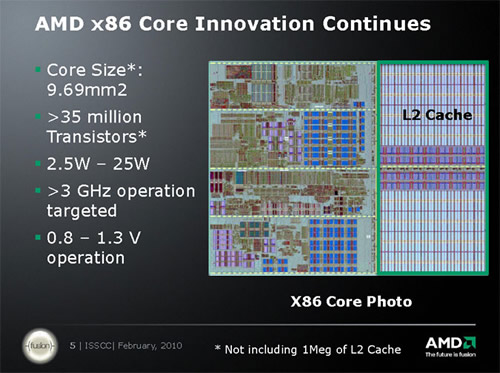AMD has been talking up its Fusion microprocessor plans for quite some time, ever since it acquired ATI for $5.4 billion in 2006, but for the most part the company has abstained from discussing its upcoming GPU/CPU hybrid in detail. Having missed its original May 2009 launch timeframe, and with Intel's Westmere CPUs featuring built-in graphics already out, it seems AMD is now ready to share a little more.
Speaking at the International Solid State Circuits Conference (ISSCC) in San Francisco this week, AMD's Sam Naffziger said the upcoming 'Llano' Accelerated Processing Unit (APU) will see the joining of its first 32nm Phenom II quad core CPU with a DirectX 11 capable GPU on the same die. This is a much more sophisticated approach than Intel's at present, which simply adds a separate 45nm GPU to the processor package.

Naffziger didn't reveal specific speeds of the graphics unit, but he said it will be a derivative of the current Radeon HD 5000 series and that it will not link to the cores through a HyperTransport link. Instead, it will use a more direct link on the die. Llano's CPU clock speeds are expected to surpass the 3GHz threshold and AMD is aiming for power consumption in the 2.5W to 25W range per core -- with the ability to shut down unused cores.
The chip will also integrate a DDR3 memory controller, 512KB L1 and 1MB L2 Cache per core. There's no shared L3 cache though. In any case, Llano is looking quite promising for the mobile sector, but with a launch scheduled for 'sometime in 2011' Intel's current platform will have a significant head start. If both companies stay on track, Llano should go up against Intel's next major architecture shift, dubbed Sandy Bridge, which will also have graphics on-die but is only expected to support DirectX 10.
https://www.techspot.com/news/37865-amd-talks-up-its-first-fusion-chip-the-llano-apu.html